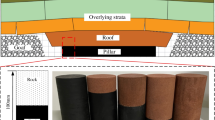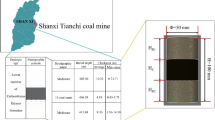Abstract
To explore the differences in mechanical and energy evolution characteristics of coal–rock composite samples with different coal–rock height ratios, uniaxial compression tests of coal–rock composite samples with height ratios ranging from 4:1 to 1:4 were conducted by PFC software. A total of 7 PFC models were built and calculated. Results show that the smaller coal–rock height ratios lead to the higher elastic modulus and higher peak strength, both following exponential relationships with coal–rock height ratios, while the peak strain decreases linearly with the decrease of coal–rock height ratios. When the coal–rock height ratios decrease from 4:1 to 1:3, the fragmentation degree of coal body decreases gradually, and the failure modes are mainly of “V” type. And when the ratio is reduced to 1:4, failure mode is no longer of “V” type, the degree of coal body breaking becomes larger, and the part of rock body in the composites is also damaged. With the decrease of coal–rock height ratios, number of acoustic emission events of the composites increase first and then decrease. And U, \(U_{e}\) and \(U_{d}\) at different coal–rock height ratios exhibited similar trends, all of which increase slowly first, fast afterwards and very sharply at the peak stress points. At the peak stress point, the values of total input energy (\(U_{A}\)) and dissipative energy (\(U_{A} {d}\)) decrease firstly then increase as the coal-rock height ratios decreases and the value of elastic strain energy (\(U_{A} {e}\)) decrease as coal-rock height ratios decreases. While the decrease of both \(U_{A}\) and \(U_{A} {d}\) are larger than \(U_{A} {e}\). These results can provide a useful reference for safe and efficient exploitation of coal resources.












Similar content being viewed by others
References
Álvarez-Fernández MI, González-Nicieza C, Álvarez-Vigil AE, HerreraGarcía G, Torno S (2009) Numerical modeling and analysis of the influence of local variation in the thickness of a coal seam on surrounding stresses: application to a practical case. Int J Coal Geol 79:157–166
CESA (2019) Metallurgical Industry Energy Saving Committee of China Energy Saving Association (CESA). China's steel industry energy saving and low carbon development report in 2019
Chen YL, Wu HS, Zhang MW, Wu Y, Zhang HQ, Zhang GM (2016) Research on the upper protective coal seam mining effect induced by coal thickness and inter burden rock properties. J Min Saf Eng 33(4):578–584
Chen YL, Zuo JP, Liu DJ, Wang ZB (2018) Deformation failure characteristics of coal-rock combined body under uniaxial compression: experimental and numerical investigations B. Eng Geol Environ 3:1–16
Chen SJ, Yin DW, Jiang N, Wang F, Zhao ZH (2019) Mechanical properties of oil shale-coal composite samples. Inter J Rock Mech Min Sci 123:104120
Cheng ZB, Li LH, Zhang YN (2019) Laboratory investigation of the mechanical properties of coal-rock combined body. Bull Eng Geol Environ 79:1947–1958
Cho N, Martin CD, Sego DC (2007) A clumped particle model for rock. Int J Rock Mech Min Sci 44(7):997–1010
Cundall PA, Strack ODL (1980) Discussion: a discrete numerical model for granular assemblies. Géotechnique 30(3):331–336
Gong FQ, Ye H, Luo Y (2018) The effect of high loading rate on the behavior and mechanical properties of coal-rock combined body. Shock Vib. https://doi.org/10.1155/2018/4374530
Guo WY, Tan YL, Yu FH, Zhao TB, Hu SC, Huang DM, Qin ZW (2018) Mechanical behavior of rock-coal-rock specimens with different coal thicknesses. Geomech Eng 15(4):1017–1027
Hou ZK, Gutierrez M, Ma SQ, Almrabat A, Yang CH (2019) Mechanical behavior of shale at different strain sates. Rock Mech Rock Eng 52(10):3531–3544
Hu SC, Tan YL, Zhou H, Ru WK, Ning JG, Wang J, Huang DM, Li Z (2019) Anisotropic modeling of layered rocks incorporating planes of weakness and volumetric stress. Energy Sci Eng 00:1–15
Huang WP, Li C, Zhang LW, Yuan Q, Zheng YS, Liu Y (2018) In situ identification of water-permeable fractured zone in overlying composite strata. Inter J Rock Mech Min Sci 105:85–97
Kenetia A, Sainsbury BA (2018) Review of published rockburst events and their contributing factors. Eng Geol 246:361–373
Liu SH, Mao DB, Qi QX, Li FM (2014) Under static loading stress wave propagation mechanism and energy dissipation in compound coal-rock. J China Coal Soc 39(S1):15–22
Liu XS, Ning JG, Tan YL, Gu QH (2016) Damage constitutive model based on energy dissipation for intact rock subjected to cyclic loading. Int J Rock Mech Min Sci 85:27–32
Liu XS, Tan YL, Ning JG, Lu YW, Gu QH (2018) Mechanical properties and damage constitutive model of coal in coal-rock combined body. Inter J Rock Mech Min Sci 110:140–150
Lockner DA (1993) The role of acoustic emission in the study of rock fracture. Int J Rock Mech Min Sci Geomech Abstr 30(7):883–899
Ma Q, Tan YL, Liu XS, Gu QH, Li XB (2020) Effect of coal thicknesses on energy evolution characteristics of roof rock-coal-floor rock sandwich composite structure and its damage constitutive model. Compos Part B-Eng 198:108086
Mansurov VA (1994) Acoustic emission from failing rock behavior. Rock Mech Rock Eng 27(3):173–182
Mikhalyuk AV, Zakharov VV (1997) Dissipation of dynamic-loading energy in quasi-elastic deformation processes in rocks. J App Mech Tech Phys 38(2):312–318
Mishra B, Verma P (2015) Uniaxial and triaxial single and multistage creep tests on coal-measure shale rocks. Int J Coal Geol 137:55–65
Ning JG, Wang J, Tan YL, Xu Q (2020) Mechanical mechanism of overlying strata breaking and development of fractured zone during close-distance coal seam group mining. Int J Min Sci Technol 30(2):207–215
Poulsen BA, Shen BT, Williams DJ, Huddlestone-Holmes C, Erarslan N, Qin J (2014) Strength reduction on saturation of coal and coal measures rocks with implications for coal pillar strength. Int J Rock Mech Min Sci 71:41–52
Sun W, Zhang Q, Luan YZ, Zhang XP (2018) A study of surface subsidence and coal pillar safety for strip mining in a deep mine. Environ Earth Sci 77:627
Tan YL, Guo WY, Gu QH, Zhao TB, Yu FH, Hu SC, Yin YC (2016) Research on the rock burst tendency and AE characteristics of inhomogeneous coal-rock combination bodies. Shock Vib. https://doi.org/10.1155/2016/9271434
Tan YL, Liu XS, Shen BT, Ning JG, Gu QH (2018) New approaches to testing and evaluating the impact capability of coal seam with hard roof and/or floor in coal mines. Geomech Eng 14(4):367–376
Tan YL, Fan DY, Liu XS, Song SL, Li XF, Wang HL (2019a) Numerical investigation on failure evolution of surrounding rock for super-large section chamber group in deep coal mine. Energy Sci Eng 7:3124–3146
Tan YL, Guo WY, Xin HQ, Zhao TB, Yu FH, Liu XS (2019b) Key technology of rock burst monitoring and control in deep coal mining. J China Coal Soc 44(01):167–179
Thomas L (2002) Coal geology. John Wiley and Sons, New York, p 384
Wang X, Tian LG (2018) Mechanical and crack evolution characteristics of coal-rock under different fracture-hole conditions: a numerical study based on particle flow code. Environ Earth Sci 77:297
Wang K, Du F, Zhang X, Wang L, Xin CP (2017) Mechanical properties and permeability evolution in gas-bearing coal-rock combination body under triaxial conditions. Environ Earth Sci 76(24):815
Wang CX, Shen BT, Chen JT, Tong WX, Jiang Z, Liu Y, Li YY (2020) Compression characteristics of filling gangue and simulation of mining with gangue backfilling: an experimental investigation. Geomech Eng 20(6):485–495
Ward CR (1984) Coal geology and coal technology. Blackwell Scientific Publications, Melbourne, p 345
Xie HP (2017) Research framework and anticipated results of deep rock mechanics and mining theory. Adv Eng Sci 49(2):1–16
Xie HP, Peng RD, Ju Y, Zhou HW (2005) On energy analysis of rock failure. Chin J Rock Mech Eng 24(15):2603–2608
Yang Z, Qi QJ, Ye DD, Li X, Luo H (2016) Variation of internal infrared radiation temperature of composite coal-rock fractured under load. J China Coal Soc 41(3):618–624
Yin DW, Chen SJ, Sun XZ, Jiang N (2019) Strength Characteristics of Roof Rock-coal Composite Samples with Different Height Ratios under Uniaxial Loading. Arc Min Sci 64(2):307–319. https://doi.org/10.24425/ams.2019.128685
Zhang ZZ (2013) Energy evolution mechanism during rock deformation and failure. China University of Mining and Technology, Beijing
Zhang XT, Dou LM (2006) Numerical simulation of the influence of coal seam hardness and thickness on rock burst. J Min Saf Eng 03:277–280
Zhang XP, Wong LNY (2012) Cracking processes in rock-like material containing a single flaw under uniaxial compression: a numerical study based on parallel bonded-particle model approach. Rock Mech Rock Eng 45:711–737
Zhang MW, Shimada H, Sasaoka T, Matsui K, Dou LM (2014) Evolution and effect of the stress concentration and rock failure in the deep multi-seam coal mining. Environ Earth Sci 72(3):629–643
Zhang Q, Zhang JX, Han XL, Ju F, Tai Y, Li M (2016) Theoretical research on mass ratio in solid backfill coal mining. Environ Earth Sci 75(7):586
Zhang YZ, Wang G, Jiang Y, Wang SG, Zhao HH, Jing WJ (2017) Acoustic emission characteristics and failure mechanism of fractured rock under different loading rates. Shock Vib 15(6):1–13
Zhang ZP, Xie HP, Zhang R, Zhang ZT, Gao MZ, Jia ZQ, Xie J (2018) Deformation damage and energy evolution characteristics of coal at different depths. Rock Mech Rock Eng 52:1491–1503
Zhang C, Liu JB, Zhao YX, Han PH, Zhang L (2020a) Numerical simulation of broken coal strength influence on compaction characteristics in goaf. Nat Resour Res 29(4):2495–2511
Zhang GC, Chen LJ, Wen ZJ, Chen M, Tao GZ, Li Y, Zuo H (2020b) Squeezing failure behavior of roof-coal masses in a gob-side entry driven under unstable overlying strata. Energy Sci Eng 8(7):2443–2456
Zhao YX, Jiang YD, Zhu J, Sun GZ (2008) Experimental study on precursory information of deformation and failure of coal rock combination. Chin J Rock Mech Eng 27(2):128–135
Zhao ZH, Wang WM, Wang LH, Dai CQ (2015) Compression-shear strength criterion of coal-rock combination model considering interface effect. Tunn Undergr Sp Tech 47(5):193–199
Zhao TB, Guo WY, Lu CP, Zhao GM (2016) Failure characteristics of combined coal-rock with different interfacial angles. Geomech Eng 11(3):345–359
Zhao ZH, Sun W, Zhang MZ, Gao XJ, Chen SJ (2020) Fracture mechanical behavior of cracked cantilever roof with large cutting height mining. Shock Vib. https://doi.org/10.1155/2020/1641382
Zhao ZH, Sun W, Chen SJ, Yin DW, Liu H, Chen BS (2021) Determination of critical criterion of tensile-shear failure in Brazilian disc based on theoretical analysis and meso-macro numerical simulation. Comput Geotech 134:104096. https://doi.org/10.1016/j.compgeo.2021.104096
Zuo JP, Xie HP, Wu AM, Liu JF (2011) Investigation on failure characteristics and mechanical behavior of deep coal-rock single body and combined body under different confining pressures. Chin J Rock Mech Eng 30(1):84–92
Acknowledgements
This study was financially supported by National Key R&D Program of China (Grant No. 2018YFC0604703), the National Natural Science Foundation of China (Grant No. 51774196, No. 51804181, No. 51874190), Key R&D Program of Shandong Province (No. 2019GSF111020), Major Program of Shandong Province Natural Science Foundation (No. ZR2018ZA0603), Shandong Province Natural Science Fund (No. ZR2018QEE002). The first author would like to thanks for financial support by the CSC.
Author information
Authors and Affiliations
Corresponding authors
Additional information
Publisher's Note
Springer Nature remains neutral with regard to jurisdictional claims in published maps and institutional affiliations.
Rights and permissions
About this article
Cite this article
Ma, Q., Tan, Yl., Liu, Xs. et al. Mechanical and energy characteristics of coal–rock composite sample with different height ratios: a numerical study based on particle flow code. Environ Earth Sci 80, 309 (2021). https://doi.org/10.1007/s12665-021-09453-5
Received:
Accepted:
Published:
DOI: https://doi.org/10.1007/s12665-021-09453-5




